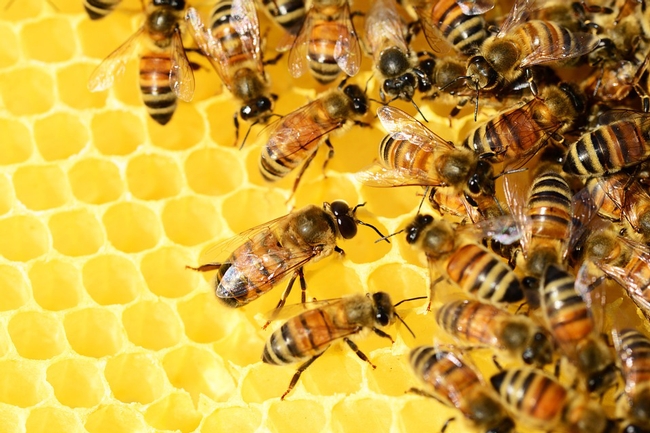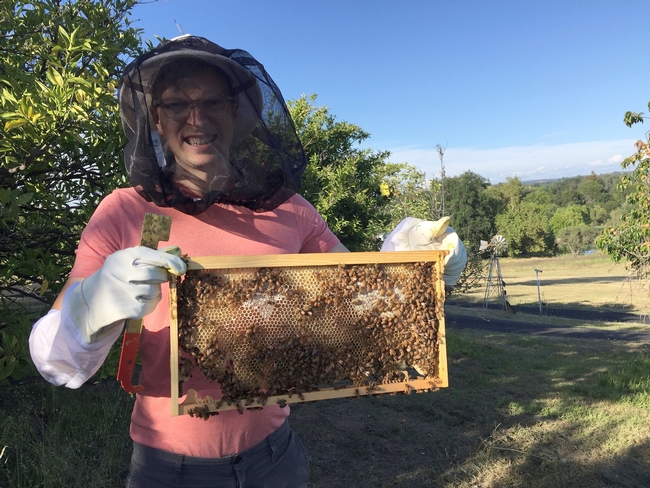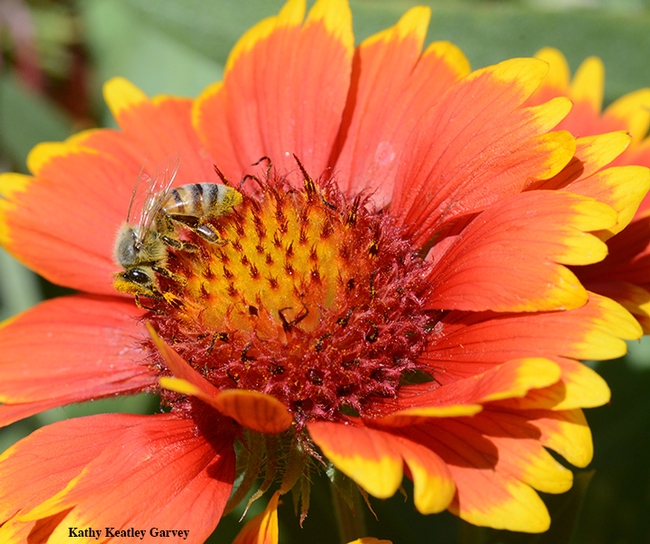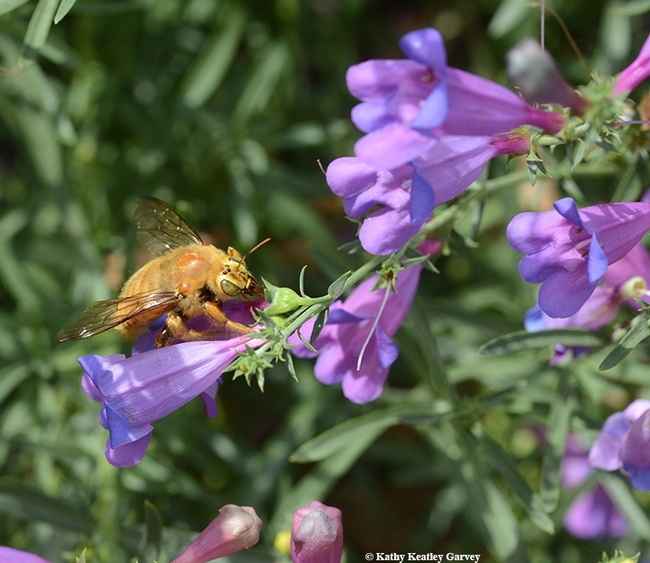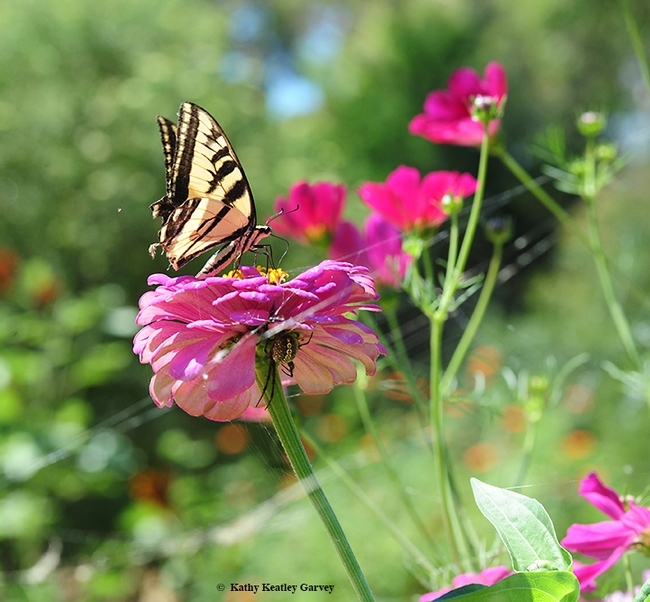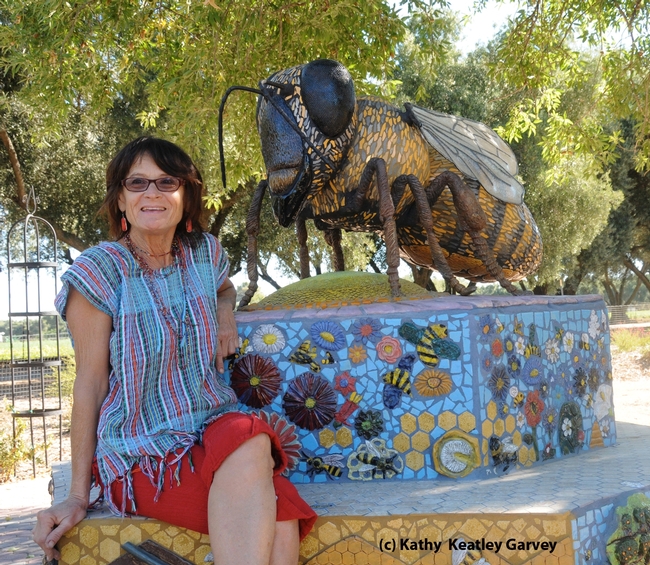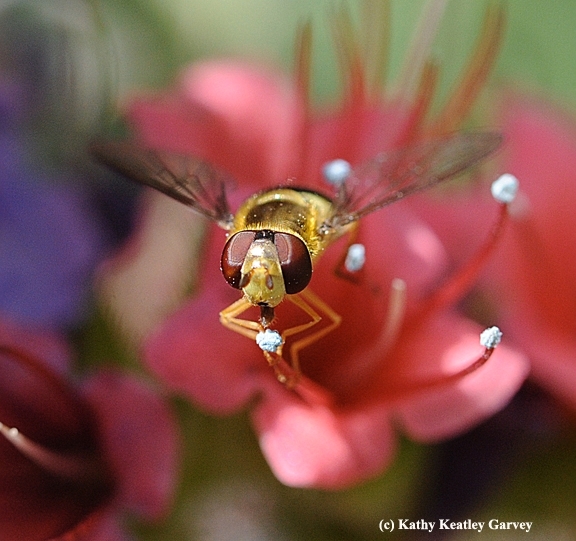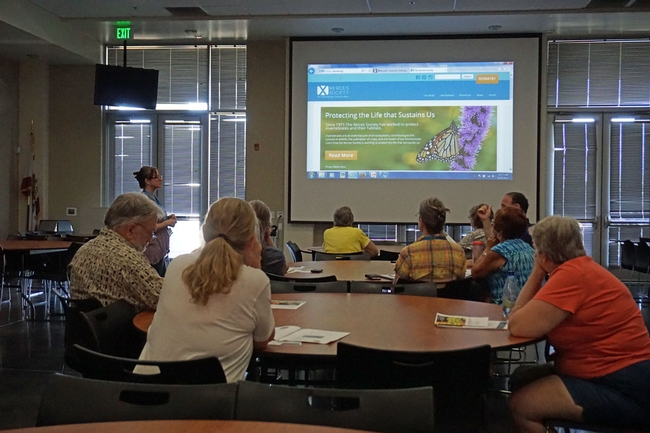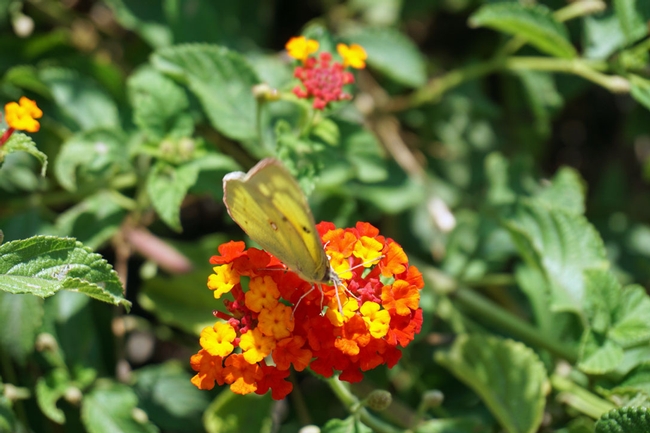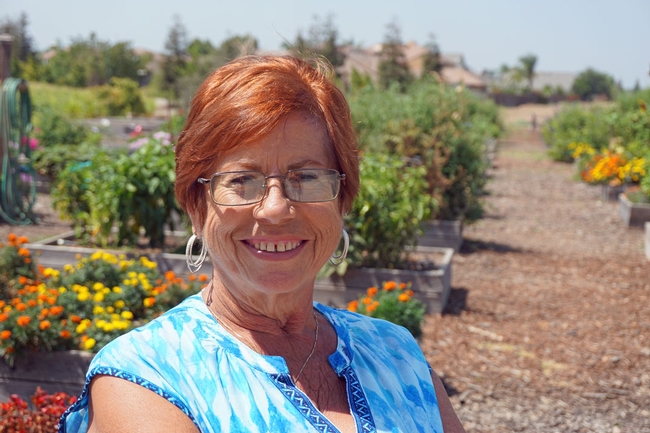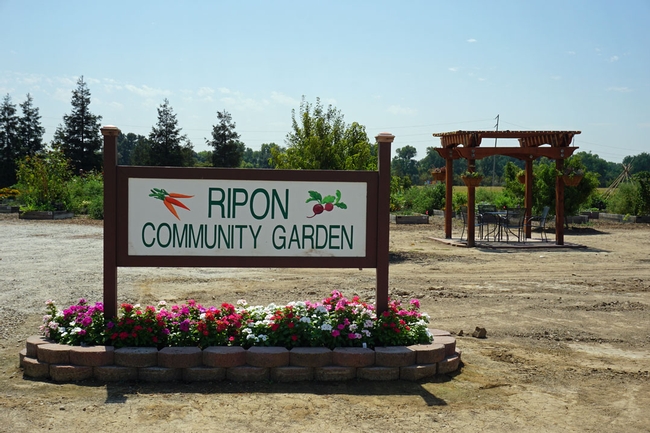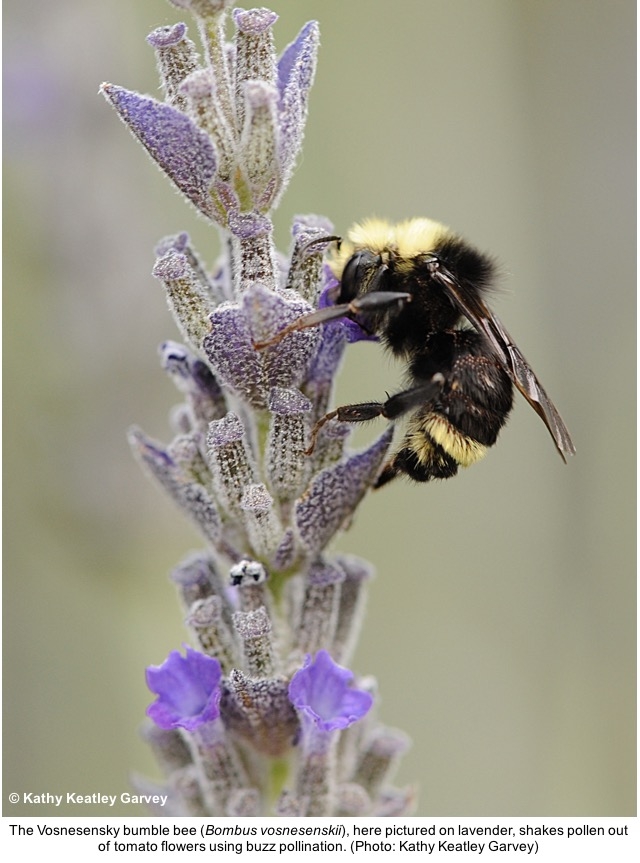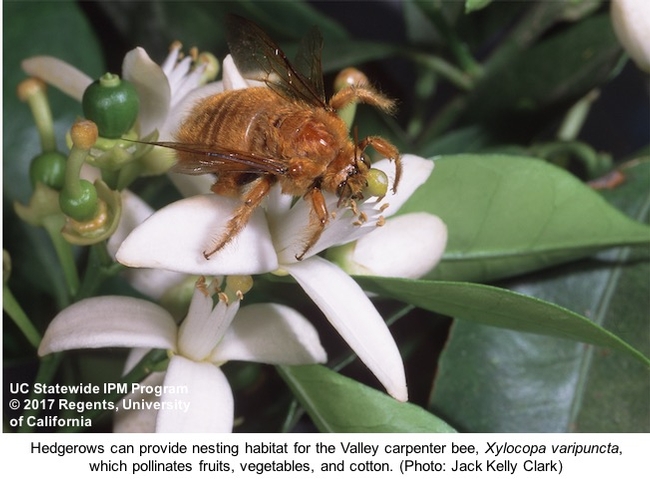Posts Tagged: Bees
Honey bee health key to wellbeing of important species
Our friends the honey bees make it possible for us to devour an abundance of almond products. In 2016 the California almond crop totaled 2.15 billion pounds valued at $5.2 billion. Growing 80 percent of the world's almonds in California takes a lot of honey bees for pollination, roughly two hives for every acre of almond trees. It's estimated that California has 1.3 million acres of almonds, stretching 400 miles between Bakersfield and Red Bluff.
California is rated in the top five honey producing states in the nation. The U.S. per capita consumption of honey is around 1.3 pounds per year. Our buzzing friends visit millions of blossoms, making pollination of plants possible and collecting nectar to bring back to the hive. Lucky for us bees make more honey than their colony needs allowing beekeepers the opportunity to remove the excess honey and bottle it for us to enjoy.
Bees are animals too
Bees are one of our planet's most important animals. They produce honey and they are the primary managed pollinators for a majority of high value specialty crops grown in the contiguous states of California and Oregon, such as nuts, stone fruits, vegetables, and berries. A problem looms for our animal friends, the bees. Colony losses are high due to a variety of environmental and biological causes including bacterial diseases. Historically, beekeepers have self-prescribed antibiotics to control these diseases.
Enter UC Davis and Oregon State University to aid beekeepers in addressing the problem of antibiotic resistance and antimicrobial use in the feed or water of food-producing animals, namely, protecting the health and safety of bees. The overall strategy leads to a safer food supply because the potential for antibiotic resistance is reduced.
The Western Institute for Food Safety and Security (WIFSS), UC Cooperative Extension, and UC Davis School of Veterinary Medicine are partnering with Oregon State University in a USDA funded multi-state specialty crop project to develop CE training for veterinarians on bee health and antibiotic use — a practice that is now regulated under the Veterinary Feed Directive (VFD). The project will offer a comprehensive bee biology online course and train-the-trainer practical training for veterinarians and apiculture educators. The ultimate goals are to protect the specialty crop — honey — from becoming contaminated with antibiotic residues; to protect the health and safety of bees, which are essential to California agriculture; and, finally, to support veterinary oversight in the use of antibiotics, which will lead to an overall reduction of antibiotic resistant bacteria in the environment.
The $483,278 award will address the unique needs of the beekeeping industry that have been experiencing high colony losses since 2006. It will also focus on new rules established by the U.S. Food & Drug Administration on the use of antibiotics which are used to control certain diseases affecting bee colonies.
The principal investigator is Elina L. Niño, a UC Cooperative Extension specialist with the UC Davis Department of Entomology and Nematology. Project leader is Bennie Osburn, director of outreach and training at WIFSS. Collaborating in the project is Jonathan Dear, from the Department of Medicine and Epidemiology at UC Davis School of Veterinary Medicine, and the partner state collaborator is Ramesh Sagili from the Department of Horticulture at Oregon State University. A team of graphic and instructional designers from WIFSS will work with Drs. Niño, Dear, and Sagili, to translate the science into user friendly information for veterinarians and beekeepers.
Educating about honey bee health
Dear who is collaborating with WIFSS to produce an online and hands-on module to train veterinarians about beekeeping and honey bee health, points out that, “Honey bees are such an important part of our economy and, like any food producing animal, they can be affected by preventable and treatable diseases.”
He is enthusiastic about the project and says, “Our hope is that by educating veterinarians about honey bee health, they can play a key role in maintaining the health and wellbeing of this important species.”
With the efforts of extension specialists, veterinarians, and graphic and instructional designers, beekeepers and veterinarians will work together to navigate the VFD regulations, and consumers will continue to enjoy nature's sugar.
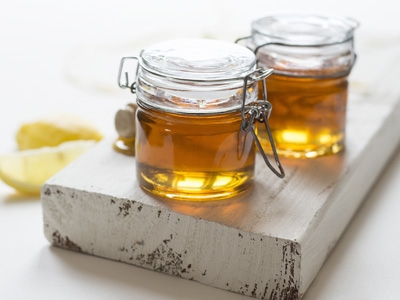
UCANR-Honey-400x300
National Pollinator Week: Open house at UC Davis Bee Garden
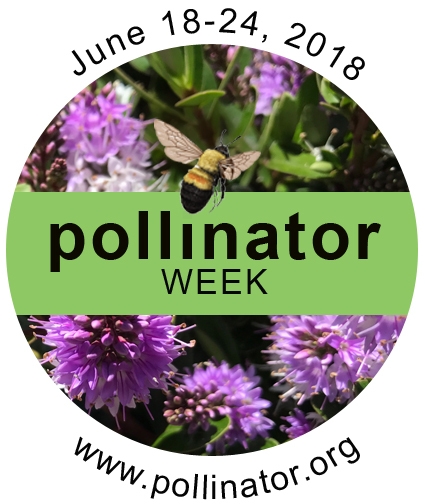
Do you know where your pollinators are? Think bees, birds, butterflies, bats and beetles.
And think flies. Especially syrphid flies, also known as "flower flies" and "hover flies."
The UC Davis Department of Entomology and Nematology is hosting an open house during National Pollinator Week from 11 a.m. to 2 p.m. at its bee garden, Häagen-Dazs Honey Bee Haven on Bee Biology Road, west of the central UC Davis campus.
Here's what you can expect to see or do:
- learn how to catch and observe bees up close
- see honey bees at work in an observation beehive
- learn about bee diversity and identification
- learn about what and how to plant for bees
- learn about growing and good pollination in home fruit gardens
- see easy-to-grow bee plants and solitary bee houses available for a donation to the garden.
The Häagen-Dazs Honey Bee Haven, installed in the fall of 2009 and located next to the Harry H. Laidlaw Jr. Honey Bee Research Facility on Bee Biology Road, off Hopkins Road, is a half-acre garden devoted to bee pollinator conservation and education. It was founded and sprang to life during the term of interim department chair, Professor Lynn Kimsey, director of the Bohart Museum of Entomology, who coordinated the entire project. Kimsey was singled out for her work when the Pacific Branch of the Entomological Society of America honored her and four others – "The Bee Team"– with the 2013 outstanding team award.
A Sausalito team – landscape architects Donald Sibbett and Ann F. Baker, interpretative planner Jessica Brainard and exhibit designer Chika Kurotaki – won the design competition. The judges were Professor Kimsey; founding garden manager Missy Borel (now Missy Borel Gable), then of the California Center for Urban Horticulture; David Fujino, executive director, California Center for Urban Horticulture at UC Davis; Aaron Majors, construction department manager, Cagwin & Dorward Landscape Contractors, based in Novato; Diane McIntyre, senior public relations manager, Häagen-Dazs ice cream; Heath Schenker, professor of environmental design, UC Davis; Jacob Voit, sustainability manager and construction project manager, Cagwin and Dorward Landscape Contractors; and Kathy Keatley Garvey, communications specialist, UC Davis Department of Entomology and Nematology.
Others with a key role in the founding and "look" of the garden included the UC Davis Art/Science Fusion Program, founded and directed by the duo of entomologist/artist Diane Ullman, professor and former chair of the UC Davis Department of Entomology, and self-described "rock artist" Donna Billick of Davis. Miss Bee Haven, a six-foot long worker bee sculpture, the work of Billick, anchors the garden. The art in the garden is the work of their students, ranging from those in Entomology 1 class to community residents. Eagle Scout Derek Tully planned, organized and built a state-of-the-art fence around the garden.
Why are pollinators so crucial? Take it from the Xerces Society for Invertebrate Conservation:
"Pollinators are essential to our environment. The ecological service they provide is necessary for the reproduction of over 85 percent of the world's flowering plants, including more than two-thirds of the world's crop species. The United States alone grows more than 100 crops that either need or benefit from pollinators, and the economic value of these native pollinators is estimated at $3 billion per year in the U.S. Beyond agriculture, pollinators are keystone species in most terrestrial ecosystems. Fruits and seeds derived from insect pollination are a major part of the diet of approximately 25 percent of all birds, and of mammals ranging from red-backed voles to grizzly bears. In many places, the essential service of pollination is at risk from habitat loss, pesticide use, and introduced diseases."
So, on Saturday, June 23, you won't see any red-backed voles or grizzly bears. But you'll see bees, butterflies, birds and beetles.
And flies. Syprhid flies.
For more information on the open house, access https://hhbhgarden.ucdavis.edu/wp-content/uploads/2018/01/Pollinator-week-flyer-2018-1.pdf
UC Master Gardeners' 5 tips to boost beneficial bees
With a little care and planning, anyone can make their little corner of the earth safe and friendly for bees.
UC Master Gardener volunteer Clare Bhakta of San Joaquin County shared bee-friendly strategies during a community workshop in August, extending the reach of research information developed by UC Agriculture and Natural Resources.
"Lure bees in," Bhakta said. "If you make it comfy, they will come."
Bhakta is a newly minted Master Gardener, having graduated in June from the intensive training program presented by UC advisors and specialists. She is part of the San Joaquin County MG speakers bureau; the "Buzz about Bees" was her inaugural engagement.
"We want bees in our gardens," Bhakta said. "Ninety percent of flowering plants and 75 percent of human crops depend on pollinators, including bees. Bee pollination makes about $15 billion in human food in the United States each year."
About 1,600 species of bees are found in California, many of them natives. Most of the bee species live independently, occupying holes in trees trunks or branches, or in the ground. Their sizes range from inch-long metallic black bumble bees to tiny sweat bees 3 millimeters in length. These species rarely sting since they don't have hives to protect.
California's most recognizable bee is the European honeybee, imported from the Old Country by settlers in the 1600s. The insects serve as efficient pollinators and produce more honey than they can use themselves - offering humans an abundance of natural golden sweetener with antioxidants, vitamins and minerals.
Bees work hard to produce honey. It takes 2 million flower visits - about 55,000 flight miles - to make a pound of honey. An individual worker bee lives just six weeks and produces about one-twelfth of a teaspoon of honey in her lifetime.
Sharon Butler, president of the Ripon Community Garden, attended the free workshop. The 2.5-acre garden at the corner of Vera and Doak avenues has dozens of raised garden plots. The community just added several bee hives. Butler asked at the workshop about an unexplained phenomenon in their first honey harvest.
"A couple of racks had dark spots with honey that had a cinnamon taste," she said.
Bhatka said the variation was probably the result of nectar from different plants.
"I wish I knew what plant it is, I'd plant a lot more," Butler said.
Creating a bee friendly garden may go against the grain for tidy gardeners. Bees don't prefer the well-trimmed plants and homogeneous color scheme of a formal outdoor space.
"Bees love herbs," Bhakta said. "I let my sage go crazy this year and I couldn't believe how tall they got."
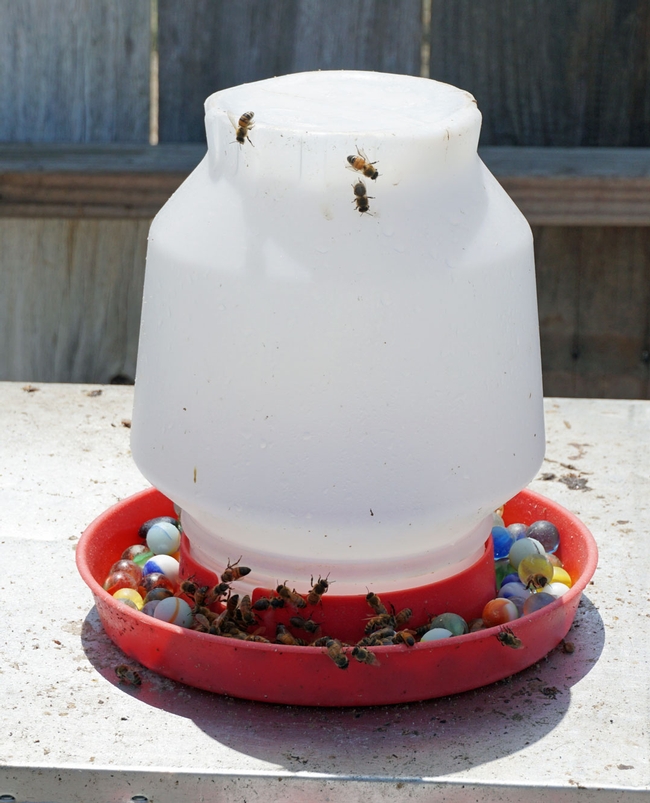
For best results, don't over garden. Follow these five tips from the UC Master Gardener program:
- Rather than cover all soil with mulch, leave open areas for ground nesting bees.
- Keep a few dead tree stumps or branches. Particularly if it has holes, it makes an ideal nesting site for solitary bees.
- Let plants "go to seed," even when they begin to look overgrown and leggy.
- Provide a shallow water source. Filling it with pebbles or marbles allows the bees access to the water.
- Avoid using pesticides. Visit the UC Integeted Pest Management website for environmentally sound methods of controlling pests and weeds.
Bee knowledgeable: Pollinator Week is June 19–25, 2017
Bees are the most important pollinators of California agriculture — helping farmers grow field crops, fruits, nuts, and vegetables. Honey bees receive most of the credit for crop pollination, but many other kinds of bees play an important role as well. There are 1600 species of bees in California! Take time during Pollinator Week to learn about the different kinds of bees and what you can do to help them flourish.
Why should I care about other kinds of bees?
Bees other than honey bees contribute significantly to crop pollination. For example, alfalfa pollination by alfalfa leafcutter bees is worth $7 billion per year in the United States. Other bees can also boost the result of honey bee pollination — in almond orchards, honey bees are more effective when orchard mason bees are present. The more bee species, the merrier the harvest.
While growers often rent honey bee colonies to pollinate their crops, some wild bees pollinate certain crops even better than honey bees do. For instance, bumble bees are more effective pollinators of tomato because they do something honey bees do not: they shake pollen out of flowers with a technique known as buzz pollination. Likewise, native squash bees are better pollinators of cucurbits — unlike honey bees, they start work earlier in the day, and males even sleep in flowers overnight.
How can I help honey bees and other bees?
When it comes to land management and pest management practices, some bees need more accommodations than others. That's why it is important to know what bees are present in your area and important to your crop, and plan for their needs. Use this bee monitoring guide to identify bees present on your farm.
You can help all kinds of bees by using integrated pest management (IPM). This means using nonchemical pest management methods (cultural, mechanical and biological control), monitoring for pests to determine whether a pesticide is needed, and choosing pesticides that are less toxic to bees whenever possible. Check out the UC IPM Bee Precaution Pesticide Ratings to learn about the risks different pesticides pose to honey bees and other bees, and follow the Best Management Practices To Protect Bees From Pesticides.
Bees also need plenty of food to stay healthy and abundant. Plant flowers that provide nectar and pollen throughout the year. See the planting resources below to find out which plants provide year-round food for specific types of bees.
Like honey bees, native bees need nesting areas to thrive. Bumble bees, squash bees, and other bees nest underground. Ground-nesting bees may require modified tilling practices (such as tilling fields no more than 6 inches deep for squash bees) or no-till management to survive. For above-ground nesters, like carpenter bees and mason bees, consider planting hedgerows or placing tunnel-filled wooden blocks around the field. See the habitat resources below for more information about native bee nesting in agricultural areas.
Bee habitat resources
- Habitat for Bees and Beneficials
- Managing Wild Bees for Crop Pollination
- Native Bee Nest Locations in Agricultural Landscapes
- Farming for Bees: Guidelines for Providing Native Bee Habitat on Farms
- Hedgerow Planting for Pollinators: Central Valley, Central Coast, Southern California
- Conservation Cover for Pollinators: Central Valley, Central Coast, Southern California
- The Integrated Crop Pollination Project: Tools for Growers
Sources
- Insect Pollinated Crops, Insect Pollinators and U.S. Agriculture: Trend Analysis of Aggregate Data for the Period 1992–2009.
- Native bees are a rich natural resource in urban California gardens. (PDF)
- Honey bees are more effective at pollinating almonds when other species of bees are present.
Twelve rules of thumb for creating a bee-friendly home landscape this fall
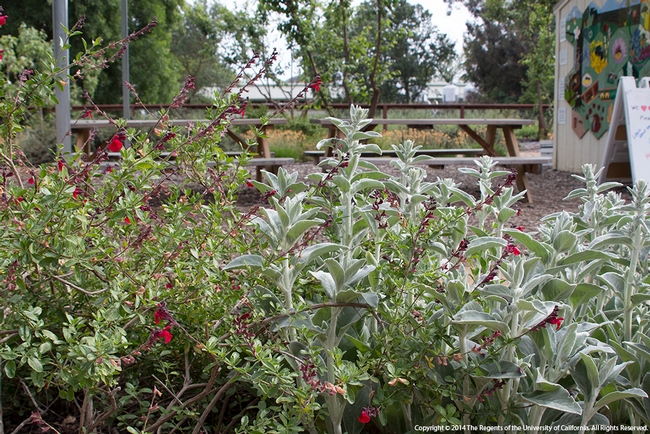
“Fall, with its cooler temperatures, shorter days, and imminent rainfall, is the best time to plant a bee garden in California. Much of the plants' growth at this time will be in the roots rather than the vegetative growth, and that gives new plants an advantage when temperatures warm up and the soil dries in the spring. Fall and winter are usually the wet seasons in California, and a bee garden will benefit from the natural pattern of rainfall that helps plants get established,” according to California Bee-Friendly Garden Recipes (Pawelek et al. 2015)
With fall being the perfect time for planting consider making your home landscape bee-friendly and follow UC Agriculture and Natural Resources' California Bee-Friendly Garden Recipes - 12 rules of thumb for creating a bee-friendly home landscape:
- Learn the seasonality of plants and bees.
Bees need both pollen and nectar resources from plants all year long. Sugary nectar provides energy for adult bees, and protein-rich pollen is used to feed their young. Plant not only a variety of plants (to ensure both pollen and nectar resources) but also make sure that they bloom at different times throughout the year, with the most active times of bees in garden running from February to October. - Provide a diversity of floral hosts.
A large variety of plants in a garden attracts a more diverse bee population. UC ANR researchers recommend planning a minimum of 20 different plant types to provide plenty of nectar and pollen sources for bees. If space or resources don't allow, consider plants that provide both nectar and pollen resources such as seaside daisy (Erigeron glaucus), blanketflower (Gaillardia x grandiflora), thyme (Thymus vulgaris), and coneflower (Echinacea purpurea). - Give structure to the garden.
When planning your garden arrange plants so it is easy to observe the bees that are visiting your landscape. Place taller plants or shrubs in the back and smaller or shorter plants in the front. Or you can plant in the shape of an island to allow viewing from all sides. - Plant in the sun.
Typically bees prefer flowers in the sunshine over the shade. Monitor the amount and location of sun in your home landscape and plant sun-loving bee-attractive plants in the sunniest section of your yard. - Plant shrubs, perennials and annuals in patches.
Most bees will visit one type or a few types of flowers each time they forage, an abundance of the same flower variety allows for more efficient foraging for bees. The California Bee-Friendly Garden Recipes publication recommends a 3.5 ft x 3.5 ft flower patch of the same variety. - Don't forget to seed annuals.
Plant seeds for spring blooming annuals and bulbs in the fall and take advantage of the winter rains and provide beautiful flowers in the spring. Great options include sunflowers (Helianthus annuus), Mexican sunflower (Tithonia diversifolia), California poppy (Eschscholzia californica), and zinnia (Zinnia elegans). - Maintain flowers.
Prolong a plant's blooming season by dead-heading. As soon as flowers begin to fade, wither and brown, pinch or cut-off the flower stem below the flower or right above the first set of healthy leaves. This allows the plant to continue to invest in producing more blooms and not seeds. - Create a watering regimen.
Regular watering of plants during blooming season allows plants to produce more flowers for a longer period of time. If a plant is water stressed it won't produce new flowers and nectar and pollen production declines. Consider plants that thrive in California's dry Mediterranean climate, UC Berkeley's Urban Bee Lab offers a list of the best bee plants with a large selection of California native options. - Do not use pesticides!
Applying pesticides to your home landscape can kill beneficial insects and bugs visiting your garden, including bees. Consider using integrated pest management practices that are natural or organic methods like hand-picking, spraying with water or natural insecticides. Contact your local UCCE Master Gardener Program to learn more about integrated pest management. - Consider plant climate zones.
Consider right plant, right place when selecting plants for your home landscape. Most gardening books, websites, plant labels and seed packets refer to a plants hardiness zone, climate zone or growing zone. Become familiar with the climate or microclimate in your area, the USDA Plant Hardiness Map and the Sunset Zone Map are a great starting guide for determining what plants will thrive in your garden space. - Provide homes for nesting bees.
A bee-friendly garden provides cover and a safe place for bees to raise young. Most bee habitats are either in the ground or in pre-existing cavities. Provide a nesting home for bees in your garden by leaving a small section of your landscape unmulched for ground-nesting bees. Nesting blocks, drilled holes in untreated wood or “bee-condos” can be offered to bees that prefer a pre-existing cavity habitat. - Provide nesting materials, including a water source.
Bees build their nests with mud, plant leaves and resins. Bees require a water source to not only drink but also to make mud for nest building. Fill a shallow water dish or birdbath to your garden, add small rocks or a floating cork for bees to rest and to prevent drowning.
Learn more with UC ANR and the UC Master Gardener Program
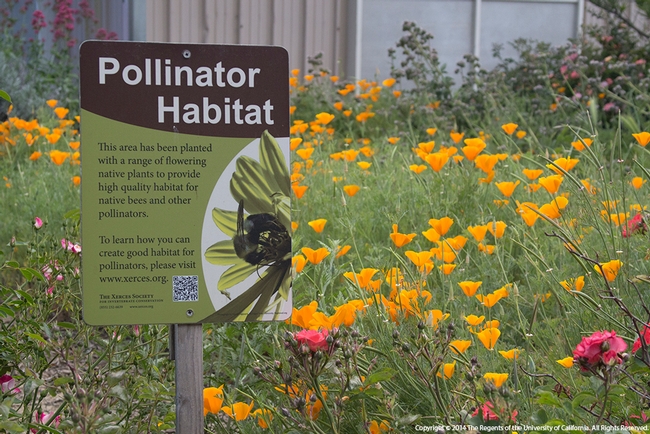
Interested in learning more about how to grow a buzzing bee-friendly garden? The UC Master Gardener Program has University trained volunteers who are eager to help. Volunteers are available to answer questions about preparing your soil, plant selection, pest management, and more. With local programs based in more than 50 counties across California and thousands of workshops a year there is sure to be an event or class near you. Visit our website to find your local UC Master Gardener Program, mg.ucanr.edu.
Resources:
Pawelek, Jaime C., Frankie, Gordon W., Frey, Kate, Leon Guerrero, Sara, and Schindler, Mary. 2015. “California Bee Friendly Garden Recipes.” ANR Publication 8518, http://anrcatalog.ucanr.edu/pdf/8518.pdf
Ponder, Marissa, Frankie, Gordon W., Elkins, Rachel, Frey, Kate, Coville, Rollin, Schindler, Mary, Pawelek, Jaime, and Shaffer, Carolyn. 2013. “How to Attract and Maintain Pollinators in your Garden.” ANR Publication 8518, http://anrcatalog.ucanr.edu/pdf/8498.pdf
UC Berkeley Urban Bee Lab, www.helpabee.org
Pollinator partnership, www.pollinator.org
